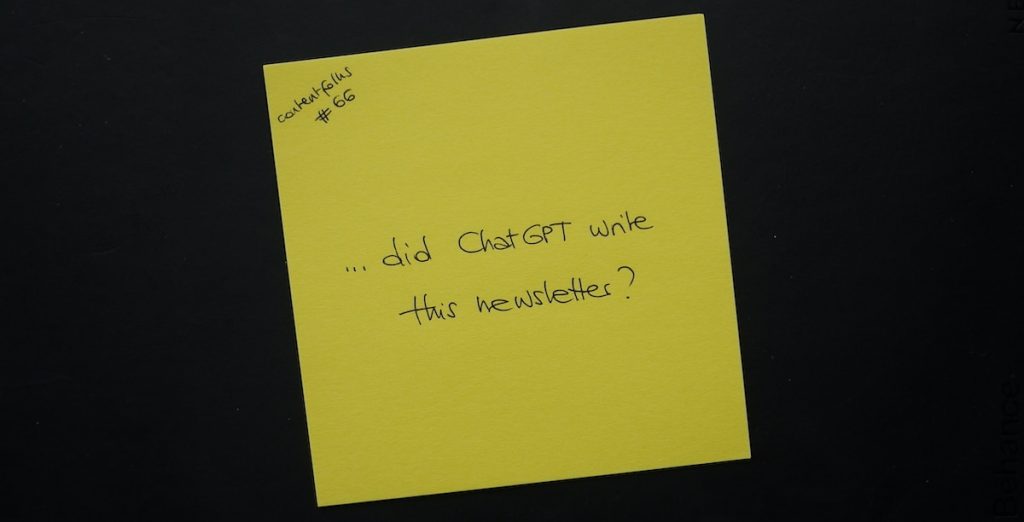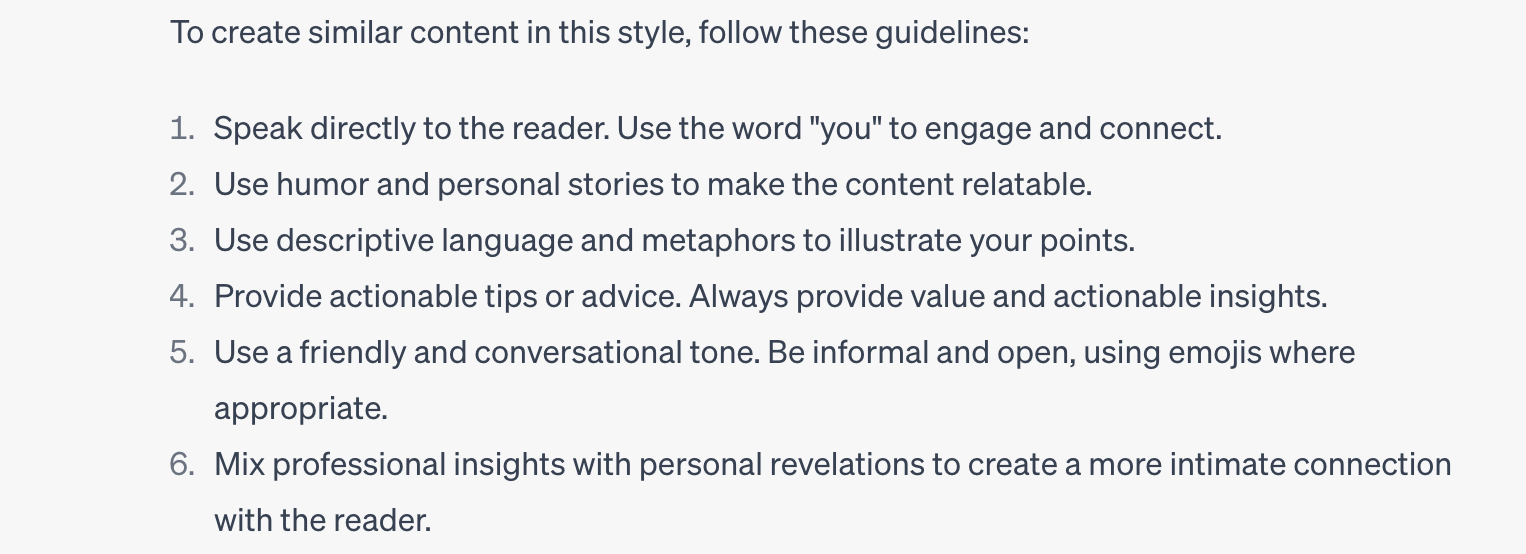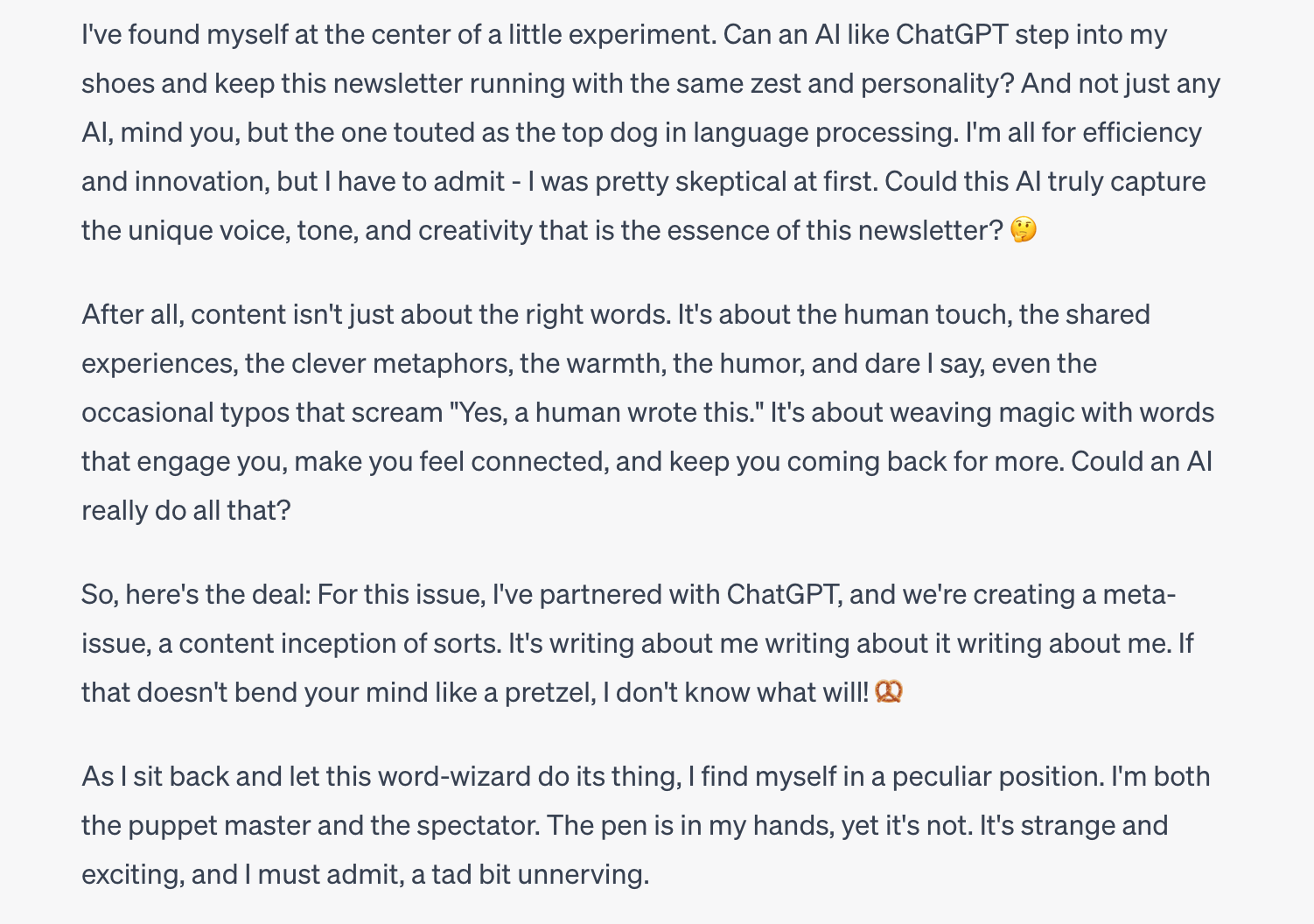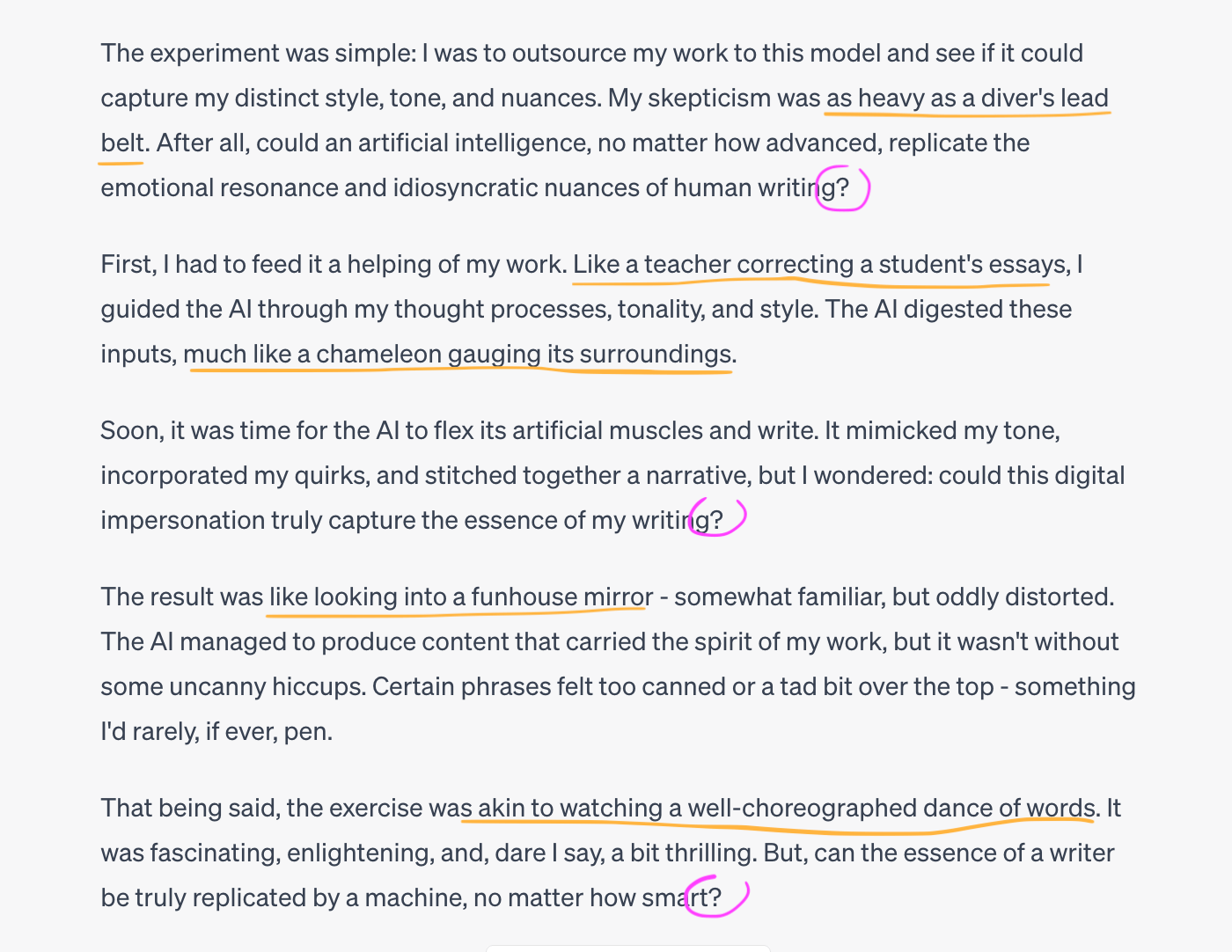
You are reading contentfolks—a fortnightly blend of sticky notes, big content ideas, and small practical examples. Thank you for being here! ~fio
Hey there 👋
Most humans struggle with the fear of being replaced. And as content folks at this particular point in time, you and I are probably experiencing a specific professional subset of this fear: the “will I be replaced by AI?” one.
Instead of abstractly asking myself the question, I thought I’d find out. Last week I paid $20 for ChatGPT 4, trained it on a corpus of my previous newsletters, and asked it to produce a meta issue—one in which it would pretend to be me and write about itself writing about me.

It will surprise precisely no one that ChatGPT didn’t, in fact, manage to replace me. It did do a few very good things though, and wrote a solid line about pretzels. I’ll show you below 😉
Part 1: training the 🤖
I started by summarising my plan and asking for a set of instructions to get it done:

I pasted three issues of this newsletter in, and within a few seconds ChatGPT had analysed them and given an accurate but basic read:

I then tried the web browsing model, where you give it a list of URLs to crawl instead of copy-pasting the content in. Based on this larger corpus, it revised the previous answer and added more details:

It also came up with a set of six rules for writing and sounding like me:

These were accurate, but also extremely generic. You could apply them to a lot of writing that isn’t mine. I kept tinkering and tried a bunch of differently worded prompts, but couldn’t quite get ChatGPT to produce a convincing blueprint for making me, me.
Key observations:
✅ ChatGPT is super valuable for running textual analysis, extracting topics from large datasets, and detecting language patterns. If that’s part of your tasks as an editor, writer, or researcher, you can (and should) use it to make your life simpler
⚠️ Despite being a generative AI application, it doesn’t seem particularly impressive at generating in-depth or extremely specific recommendations. It also doesn’t look like it can pinpoint exactly what makes a person or a brand’s style unique, which in turn makes it unlikely it can fully replicate or replace it.1
Part 2: getting the 🤖 to write on my behalf
After some more calibration, I gave ChatGPT the task to write a contentfolks-style newsletter and describe the experiment we were running.
Here was its introduction:

I’d be curious to know if YOU think this sounds like me. As the top subject matter expert on the topic of myself, I can tell you it went wrong in at least 3 places:
It used a “right?” question, which I am highly unlikely to (and especially not in a first sentence)
It used ‘right’ twice within fifteen words, but I’m a trained editor who will spot and strike repetitions 9 times out of 10
“No man is an island” is an extended metaphor about interconnectedness, whereas “No writer is an algorithm” is just a factual statement that repeats the no X is a Y structure without adding a second layer of meaning. I like to think I’d come up with something smarter 🤷♀️
The next four paragraphs:

It’s not terrible and it does sound like someone, although again that someone is not me. It’s wordy and convoluted where I tend to be a more economical writer; also, I can smell filler sentences from a mile away, and this is a lot of competent-sounding waffle.
That said, the pretzel line was fun 🥨
I gave the chatbot a few editorial notes and asked it to rewrite a bunch of sections. Things got… worse?

First of all, where did the hamsters and dinosaur replicas come from? Bring back the pretzels! And second, it seems weird that it rewrote everything to follow a rigid formula, using a metaphor in each paragraph and a question in every other one:

At least it got one part right, though: the one where it mentions that its sentences feel oddly distorted, too canned, and a bit over the top.
“Something I’d rarely, if ever, pen,” indeed.
Key observations:
✅ ChatGPT can come up with a full draft and a couple of interesting ideas in less time than it takes you to write “boy, do I have a bad case of writer’s block today”
⚠️ This is still a text-prediction model that works by mimicking patterns. It’s kind of a spicy autocomplete designed to sound confident and convincing, but when you take the time to read its content with a critical eye, you spot repetitive patterns and a complete lack of substance
✅ While it may not sound like me, it’s not bad overall—I’ve read worse content authored by humans. I can absolutely see how you’d use it as a writing assistant. My friend Rosanna, whom I shared this with, told me: “Does it write as well as you? No. Does it sound like you? No. But it sure does sound like someone! To me, it sounds like a decent junior writer that you hired as a writing assistant.”
Part 3: editing the 🤖-generated content
By this point, it was obvious that ChatGPT could not sound like me in its first draft and wouldn’t self-edit to sound like me in the second one, either. So I decided to do the editing myself.
I imagine this is the next evolution of the in-house editor’s role anyway, and figured I’d just have a bit of fun. I picked the four central paragraphs and went to work, though the more I got into it, the less of it I saved:

After this editorial intervention, it was finally starting to sound like me—no wonder: I’d cut two-thirds of the word count and rewritten what was left! But I also knew I wasn’t going to use any of it and would just do my own thing instead.
Key observations:
✅ If you (like me) are a better editor than you are a writer, having some AI-generated content to fix might be easier than having a blank page to fill
⚠️ Editing a chatbot-generated piece to make it sound like a specific person or brand requires time, though not much more than if you were editing a junior writer who doesn’t yet have a good grasp of a brand’s tone or style
✅ ⚠️ If you want to keep a distinctive voice, there is really no substitute for just being yourself. But if you are looking to publish a lot of basic-but-acceptable stuff and not give yourself a byline, you can probably do it without having to invest much time into editing2
In conclusion
Did anyone actually think, for even a second, that I would be outsourcing writing this newsletter to a chatbot? Naaaah 😂
But on the topic of outsourcing: there was a fantastic piece published last week about how AI training was, and still is, outsourced to humans. The amount of hidden labour behind this technology is both vast and kind of bonkers when you stop to think about it:
ChatGPT seems so human because it was trained by an AI that was mimicking humans who were rating an AI that was mimicking humans who were pretending to be a better version of an AI that was trained on human writing.
Maybe this last sentence and the article as a whole will bend your mind like a pretzel, after all 🥨

Obviously, ChatGPT is only one of many tools available; there’s a bunch more out there that specifically claim they can help you create stuff that stays consistently on brand.
I am, as always, sceptical. Have you got any good examples that might prove me wrong?
Of course, just because you can doesn’t mean you should.